Impact Assessment of Diverse EV Charging Infrastructures on Overall Service Reliability
Abstract
1. Introduction
1.1. Research Background
1.2. Literature Review
1.3. Research Gaps and Contributions
- All possible charger types (level 1, level 2, and DC fast charging) and charging locations (home, workplace, public locations, and commercial charging places) are considered and seven charging infrastructures are determined. EV load profiles are estimated for all seven charging infrastructures.
- The reliability impact of individual charger types and mixed portfolios is determined by considering the developed seven charging profiles.
- Two of the most widely used reliability indices, loss of load expectation (LOLE) and loss of energy expectation (LOEE) are used to evaluate the impact of individual and mixed charger portfolios.
- Various simulation studies are performed by considering different penetration levels of EVs.
2. Charging Infrastructures
2.1. EV Load Estimation
| Algorithm 1: Vehicle driver data processing for home |
 |
2.2. Level 1 Charging
2.3. Level 2 Charging
2.4. DC-Fast Charging
3. Reliability Evaluation
3.1. Reliability Evaluation Levels and Methods
3.2. Analytical Method and Reliability Indices
3.2.1. Loss of Load Expectation (LOLE)
- Any capacity outage level that failed to meet the demand (probability of the existence of failed capacity level).
- The designated period of time.
3.2.2. Loss of Energy Expectation (LOEE)
4. Reliability Evaluation of Individual Infrastructure
4.1. Input Data and Test System
4.2. Loss of Load Expectation (LOLE)
4.3. Loss of Energy Expectation (LOEE)
5. Reliability Evaluation of Mixed Infrastructure
5.1. Case a: Equal Share of all Infrastructure
5.2. Case b: User Preference-Based Infrastructure Share
6. Conclusions
- Test results have shown that commercial fast chargers have the worst impact on the reliability of the power system while level 1 and level 2 chargers have a lower impact.
- In the case of commercial fast chargers, the reliability of the system was below the acceptable range for only a 10% penetration of electric vehicles. In the case of level 1 and level 2 chargers, reliability was within the acceptable range for up to a 25% penetration of electric vehicles.
- It has also been observed that mixed charging infrastructure portfolios enhance the reliability of the power system, i.e., LOLE and LOEE are reduced as compared to the commercial-only case despite having a fair share of fast chargers in the portfolio.
Author Contributions
Funding
Institutional Review Board Statement
Informed Consent Statement
Data Availability Statement
Acknowledgments
Conflicts of Interest
References
- Vision 2050: A Strategy to Decarbonize the Global Transport Sector By Mid-Century | International Council on Clean Transportation. Available online: https://theicct.org/publication/vision-2050-a-strategy-to-decarbonize-the-global-transport-sector-by-mid-century/ (accessed on 16 June 2022).
- Xia, Z.; Wu, D.; Zhang, L. Economic, Functional, and Social Factors Influencing Electric Vehicles’ Adoption: An Empirical Study Based on the Diffusion of Innovation Theory. Sustainability 2022, 14, 6283. [Google Scholar] [CrossRef]
- Singh, R.; Gupta, A.; Singh, D.; Paul, A.R. Design and Assessment of An Electric Vehicle Charging Station Using Hybrid Renewable Energy. Int. J. Energy Clean Environ. 2022, 23, 31–47. [Google Scholar] [CrossRef]
- Rajput, S.K.; Verma, S.; Gupta, A.; Paul, A.R.; Jain, A.; Haque, N. Environmental Impact Assessment of Coal Gasification in Hydrogen Production. IOP Conf. Series. Earth Environ. Sci. 2021, 795, 012029. [Google Scholar] [CrossRef]
- Hussain, A.; Musilek, P. Resilience Enhancement Strategies for and through Electric Vehicles. Sustain. Cities Soc. 2022, 80, 103788. [Google Scholar] [CrossRef]
- Hussain, A.; Musilek, P. Fairness and Utilitarianism in Allocating Energy to EVs During Power Contingencies Using Modified Division Rules. IEEE Trans. Sustain. Energy 2022, 13, 1444–1456. [Google Scholar] [CrossRef]
- Hou, K.; Xu, X.; Jia, H.; Yu, X.; Jiang, T.; Zhang, K.; Shu, B. A reliability assessment approach for integrated transportation and electrical power systems incorporating electric vehicles. IEEE Trans. Smart Grid 2018, 9, 88–100. [Google Scholar] [CrossRef]
- Lee, H.-J.; Oh, B.-C.; Kim, S.-W.; Kim, S.-Y. V2G Strategy for Improvement of Distribution Network Reliability Considering Time Space Network of EVs. Energies 2020, 13, 4415. [Google Scholar] [CrossRef]
- Wang, X.; Karki, R. Exploiting PHEV to Augment Power System Reliability. IEEE Trans. Smart Grid 2017, 8, 2100–2108. [Google Scholar] [CrossRef]
- Ali, A.Y.; Hussain, A.; Baek, J.W.; Kim, H.M. Optimal operation of networked microgrids for enhancing resilience using mobile electric vehicles. Energies 2021, 14, 142. [Google Scholar] [CrossRef]
- Momen, H.; Abessi, A.; Jadid, S. Using EVs as distributed energy resources for critical load restoration in resilient power distribution systems. IET Gener. Transm. Distrib. 2020, 14, 3750–3761. [Google Scholar] [CrossRef]
- Hussain, A.; Kim, H.M. EV Prioritization and Power Allocation during Outages: A Lexicographic Method-Based Multiobjective Optimization Approach. IEEE Trans. Transp. Electrif. 2021, 7, 2474–2487. [Google Scholar] [CrossRef]
- Hussain, A.; Musilek, P. A Game-Theoretic Approach for Charging Demand Management of Electric Vehicles during System Overload. In Proceedings of the 2021 IEEE Electrical Power and Energy Conference, EPEC 2021, Virtual Conference, 22–31 October 2021; Institute of Electrical and Electronics Engineers Inc.: Toronto, ON, Canada; pp. 353–358. [Google Scholar]
- Anand, M.P.; Bagen, B.; Rajapakse, A. Probabilistic reliability evaluation of distribution systems considering the spatial and temporal distribution of electric vehicles. Int. J. Electr. Power Energy Syst. 2020, 117, 105609. [Google Scholar] [CrossRef]
- Kamruzzaman, M.D.; Benidris, M. Reliability-Based Metrics to Quantify the Maximum Permissible Load Demand of Electric Vehicles. IEEE Trans. Ind. Appl. 2019, 55, 3365–3375. [Google Scholar] [CrossRef]
- Kumar, S.; Saket, R.K.; Dheer, D.K.; Holm-Nielsen, J.B.; Sanjeevikumar, P. Reliability enhancement of electrical power system including impacts of renewable energy sources: A comprehensive review. IET Gener. Transm. Distrib. 2020, 14, 1799–1815. [Google Scholar] [CrossRef]
- Galiveeti, H.R.; Goswami, A.K.; Dev Choudhury, N.B. Impact of Plug-in Electric Vehicles and Distributed Generation on Reliability of Distribution Systems. Eng. Sci. Technol. Int. J. 2018, 21, 50–59. [Google Scholar] [CrossRef]
- Božič, D.; Pantoš, M. Impact of Electric-Drive Vehicles on Power System Reliability. Energy 2015, 83, 511–520. [Google Scholar] [CrossRef]
- Kim, S.; Hur, J. A Probabilistic Modeling Based on Monte Carlo Simulation of Wind Powered EV Charging Stations for Steady-States Security Analysis. Energies 2020, 13, 5260. [Google Scholar] [CrossRef]
- Mokhtar, M.; Shaaban, M.F.; Ismail, M.H.; Sindi, H.F.; Rawa, M. Reliability Assessment under High Penetration of EVs including V2G Strategy. Energies 2022, 15, 1585. [Google Scholar] [CrossRef]
- Almutairi, A.; Salama, M.M.A. Assessment and Enhancement Frameworks for System Reliability Performance Using Different PEV Charging Models. IEEE Trans. Sustain. Energy 2018, 9, 1969–1984. [Google Scholar] [CrossRef]
- Hariri, A.M.; Hejazi, M.A.; Hashemi-Dezaki, H. Investigation of impacts of plug-in hybrid electric vehicles’ stochastic characteristics modeling on smart grid reliability under different charging scenarios. J. Clean. Prod. 2021, 287, 125500. [Google Scholar] [CrossRef]
- Zhang, D.; Kang, Y.; Ji, L.; Shi, R.; Sustainability, L.J. Coevolution and Evaluation of Electric Vehicles and Power Grids Based on Complex Networks. Sustainability 2022, 14, 7052. [Google Scholar] [CrossRef]
- Cheng, L.; Chang, Y.; Lin, J.; Singh, C. Power System Reliability Assessment with Electric Vehicle Integration Using Battery Exchange Mode. IEEE Trans. Sustain. Energy 2013, 4, 1034–1042. [Google Scholar] [CrossRef]
- Davidov, S.; Pantoš, M. Optimization Model for Charging Infrastructure Planning with Electric Power System Reliability Check. Energy 2019, 166, 886–894. [Google Scholar] [CrossRef]
- Kamruzzaman, M.; Benidris, M.; Elsaiah, S. Effective Load Demand of Electric Vehicles in Power System Adequacy Assessment. In Proceedings of the 2018 International Conference on Probabilistic Methods Applied to Power Systems, PMAPS 2018, Boise, ID, USA, 24–28 June 2018; Institute of Electrical and Electronics Engineers Inc.: Piscataway, NJ, USA, 2018. [Google Scholar]
- Alshareef, S.M. Analyzing and Mitigating the Impacts of Integrating Fast-Charging Stations on the Power Quality in Electric Power Distribution Systems. Sustain 2022, 14, 5595. [Google Scholar] [CrossRef]
- Gandoman, F.H.; Van Mierlo, J.; Ahmadi, A.; Aleem, S.H.A.; Chauhan, K. Safety and Reliability Evaluation for Electric Vehicles in Modern Power System Networks; Elsevier: Amsterdam, The Netherlands, 2019. [Google Scholar]
- Gandoman, F.H.; Ahmadi, A.; Bossche, P.V.D.; Van Mierlo, J.; Omar, N.; Nezhad, A.E.; Mavalizadeh, H.; Mayet, C. Status and Future Perspectives of Reliability Assessment for Electric Vehicles; Elsevier: Amsterdam, The Netherlands, 2019. [Google Scholar]
- Almutairi, A.; Alyami, S. Load Profile Modeling of Plug-In Electric Vehicles: Realistic and Ready-to-Use Benchmark Test Data. IEEE Access 2021, 9, 59637–59648. [Google Scholar] [CrossRef]
- EV Database Compare Electric Vehicles—EV Database. Available online: https://ev-database.org (accessed on 16 June 2022).
- Almutairi, A. Plug-In Electric Vehicles and Their Impact on Power Generation Availability: A Real Survey-Based Analysis in Saudi Arabia. Sustain. Cities Soc. 2021, 75, 103389. [Google Scholar] [CrossRef]
- Almutairi, A.; Alrumayh, O. Optimal Charging Infrastructure Portfolio for Minimizing Grid Impact of Plug-In Electric Vehicles. IEEE Trans. Ind. Inform. 2022, 18, 5712–5721. [Google Scholar] [CrossRef]
- Hussain, A.; Bui, V.-H.; Kim, H.-M. Optimal Sizing of Battery Energy Storage System in a Fast EV Charging Station Considering Power Outages. IEEE Trans. Transp. Electrif. 2020, 6, 453–463. [Google Scholar] [CrossRef]
- Zhang, P.; Qian, K.; Zhou, C.; Stewart, B.G.; Hepburn, D.M. A Methodology for Optimization of Power Systems Demand Due to Electric Vehicle Charging Load. IEEE Trans. Power Syst. 2012, 27, 1628–1636. [Google Scholar] [CrossRef]
- Billinton, R.; Allan, R.N. Power-System Reliability in Perspective. IEE Rev. 1984, 30, 231–236. [Google Scholar] [CrossRef]
- Almutairi, A. Evaluating Wind Power Generating Capacity Adequacy Using MCMC Time Series Model; University of Waterloo: Waterloo, ON, Canada, 2014. [Google Scholar]
- Grigg, C.; Wong, P. The Ieee Reliability Test System -1996 A Report Prepared by The Reliability Test System Task Force of the Application of Probability Methods Subcommittee. IEEE Trans. Power Syst. 1999, 14, 1010–1020. [Google Scholar] [CrossRef]
- Billinton, R.; Kumar, S.; Chowdhury, N.; Chu, K.; Debnath, K.; Goel, L.; Khan, E.; Kos, P.; Nourbakhsh, G.; Oteng-Adjei, J. A Reliability Test System for Educational Purposes-Basic Data. IEEE Trans. Power Syst. 1989, 4, 1238–1244. [Google Scholar] [CrossRef]
- Milligan, M.; Porter, K. Determining the Capacity Value of Wind: A Survey of Methods and Implementation. In Proceedings of the WindPower 2008, Houston, TX, USA, 1–4 June 2008. [Google Scholar]
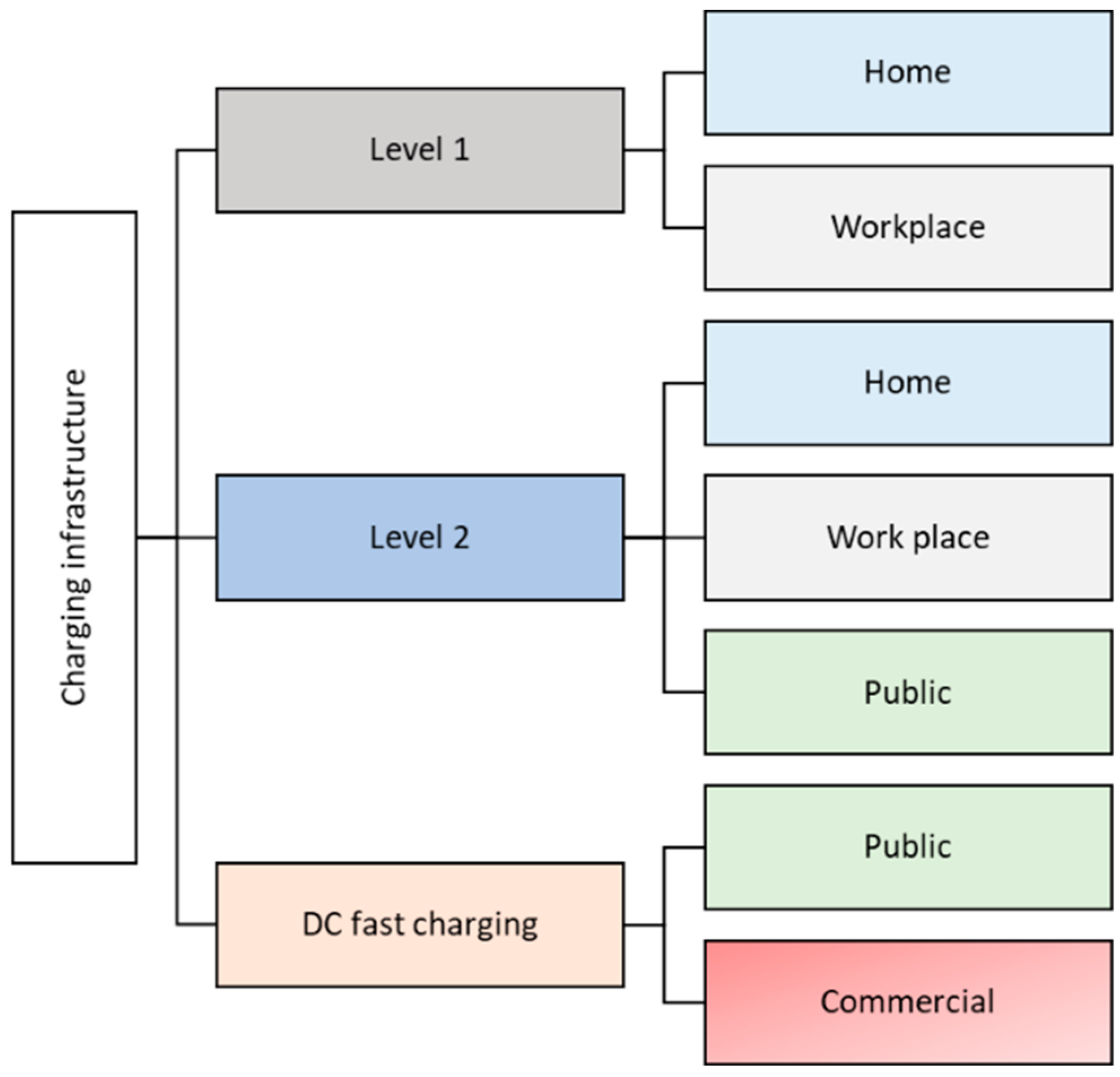
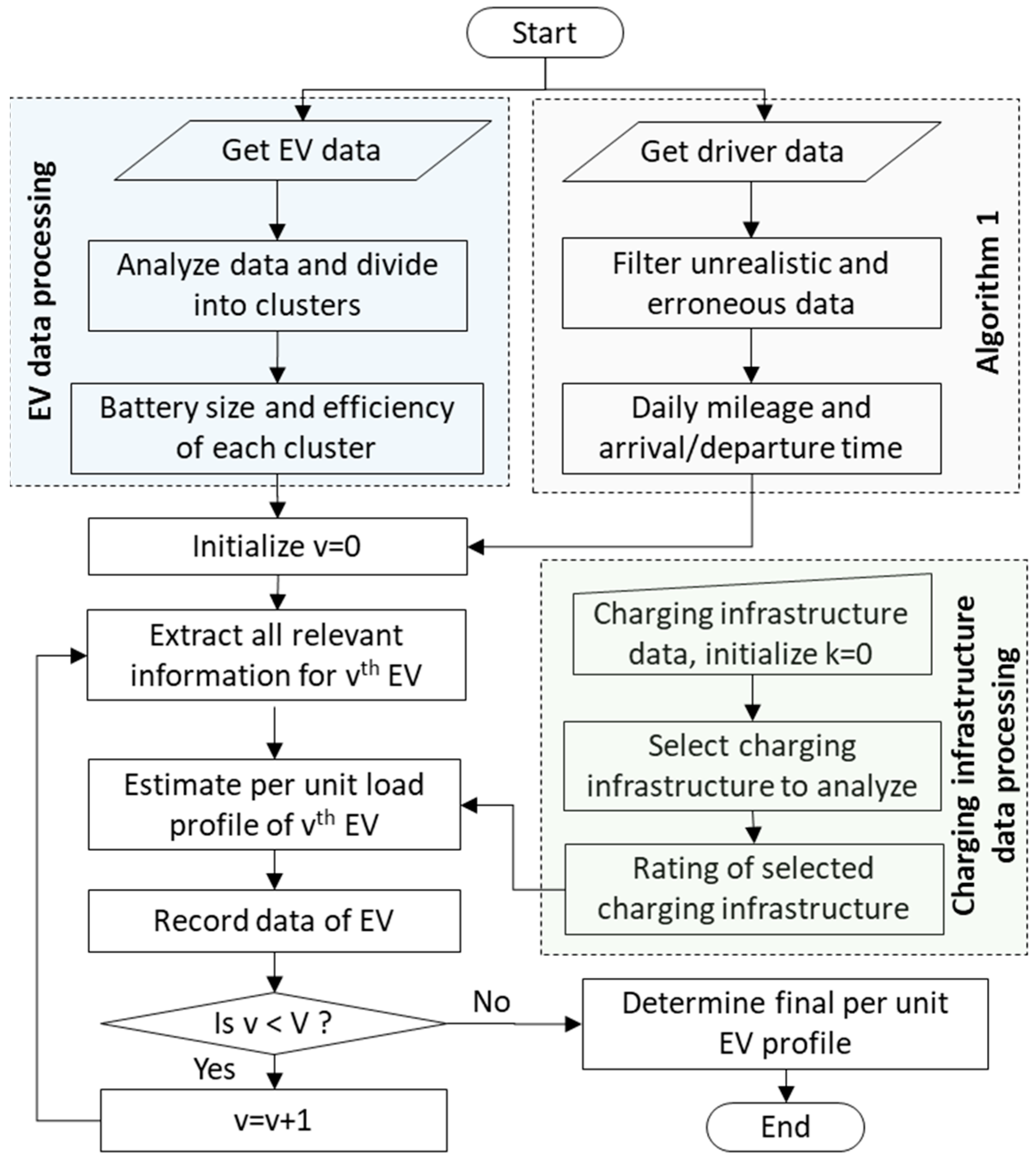
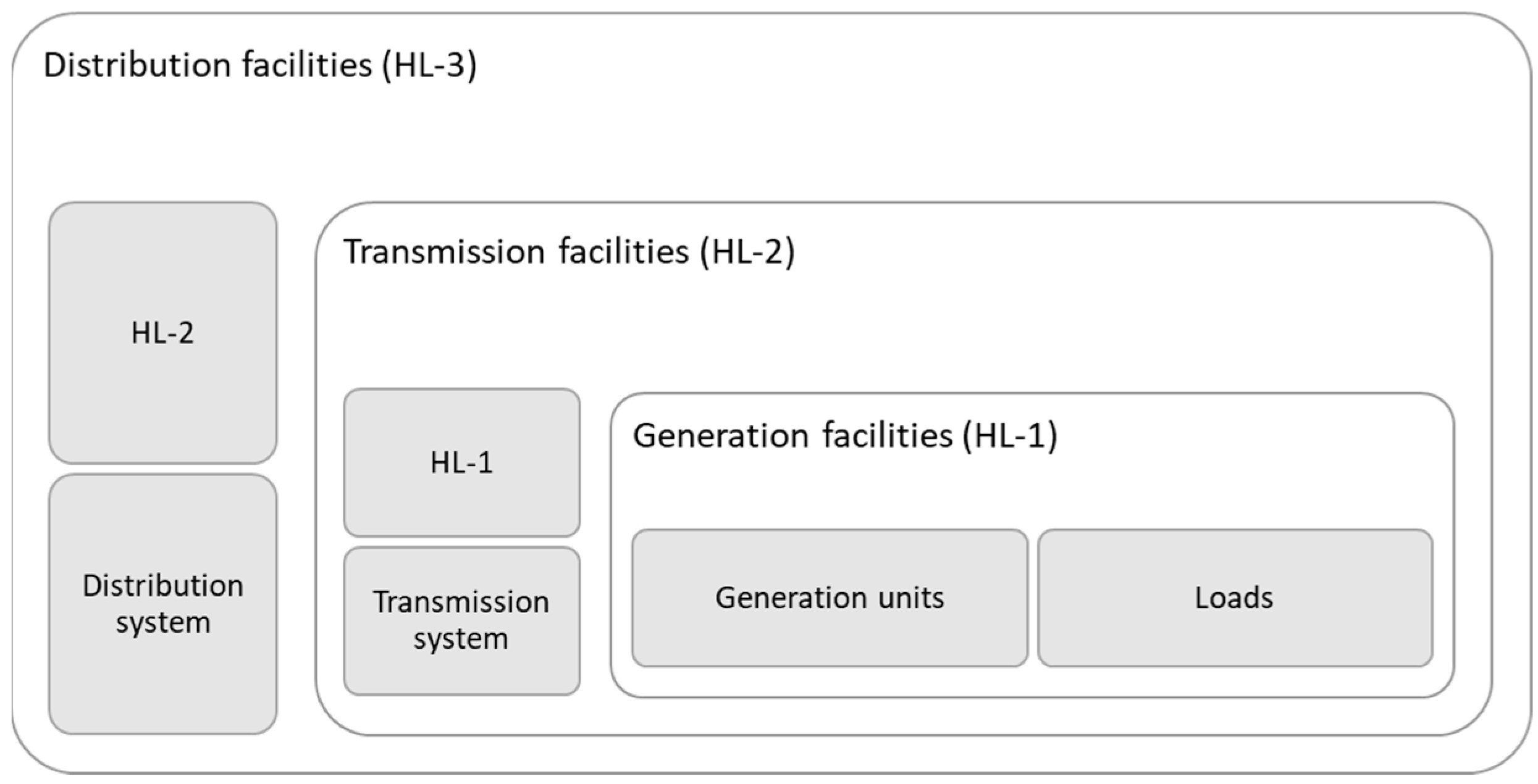

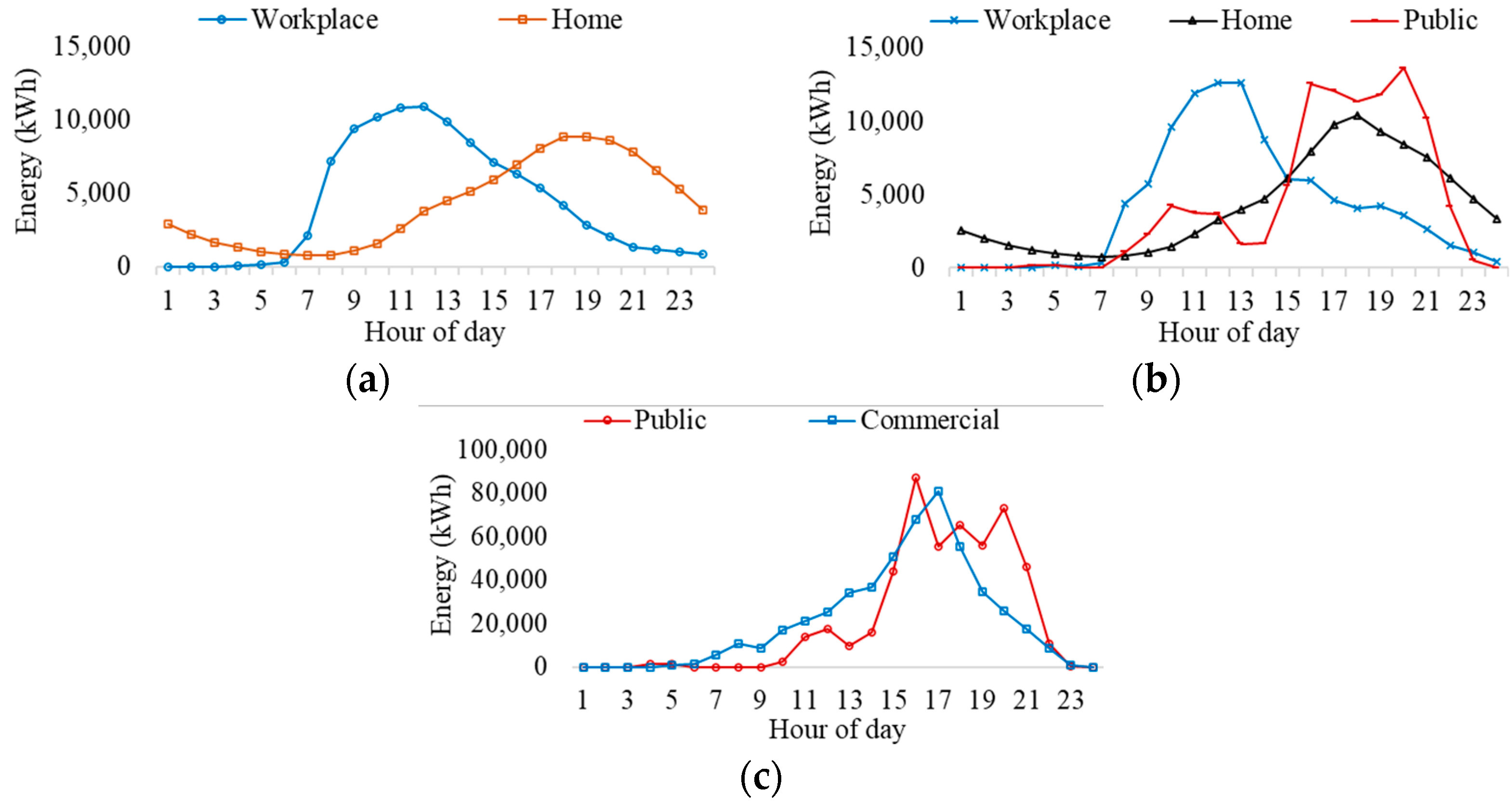
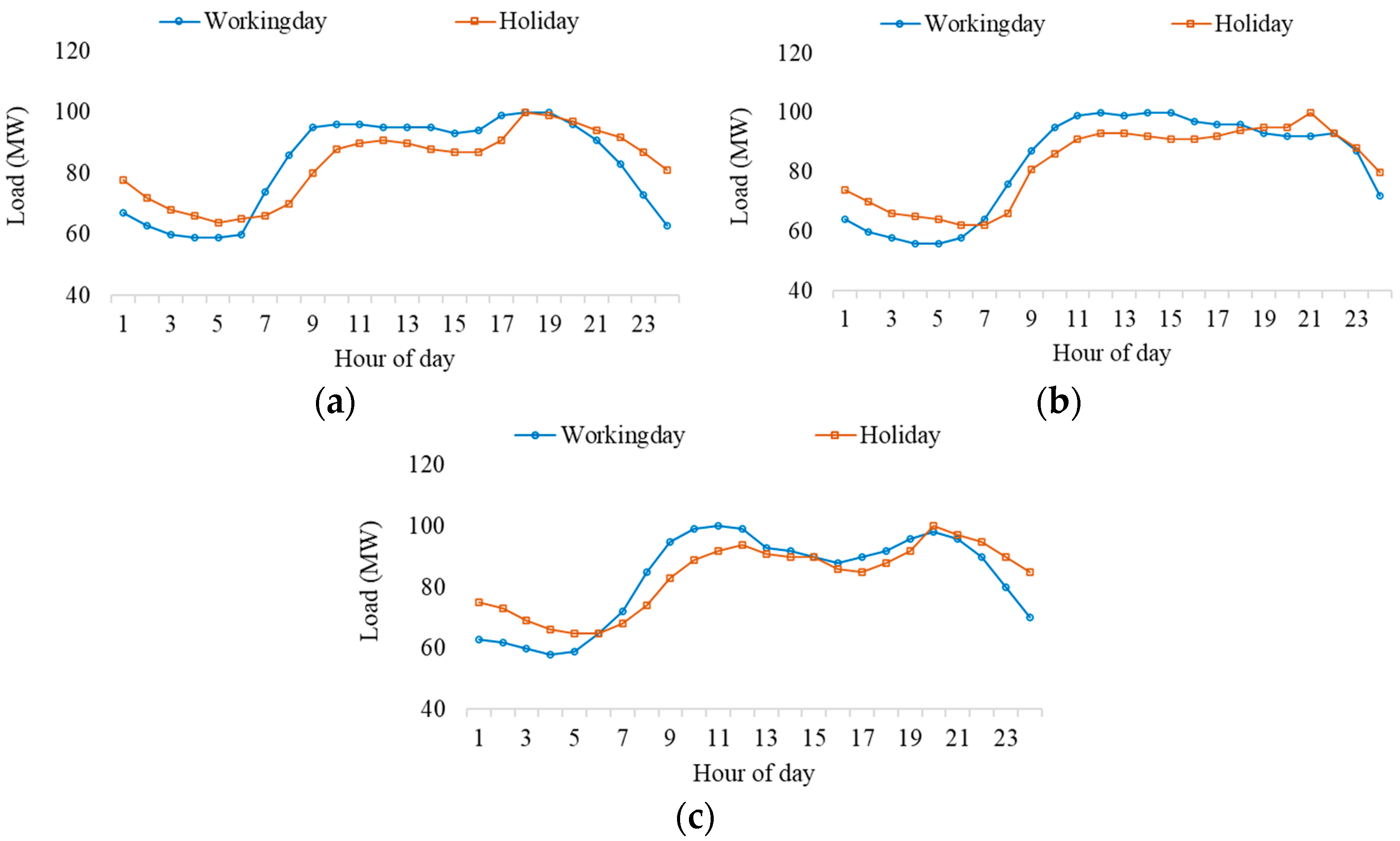
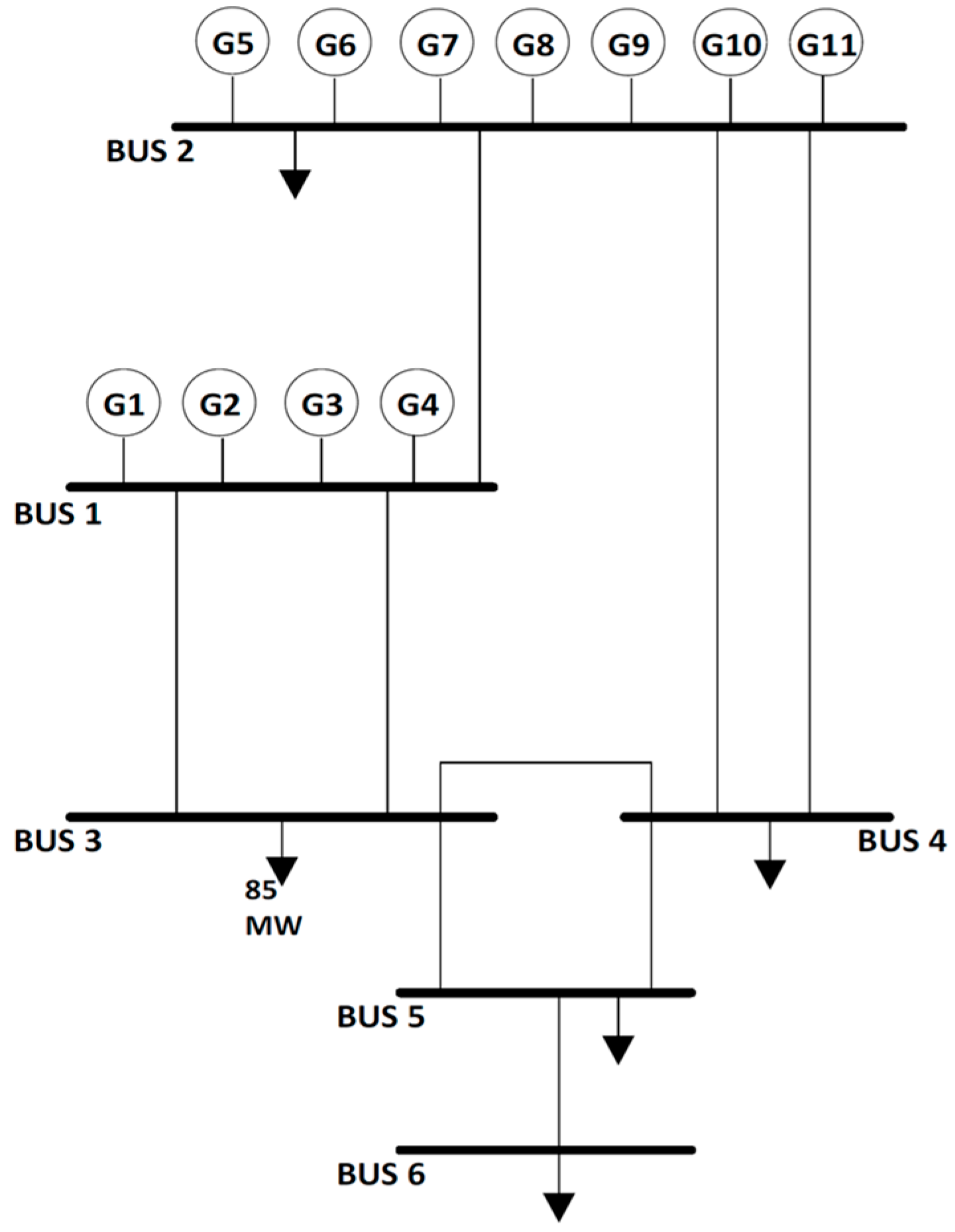


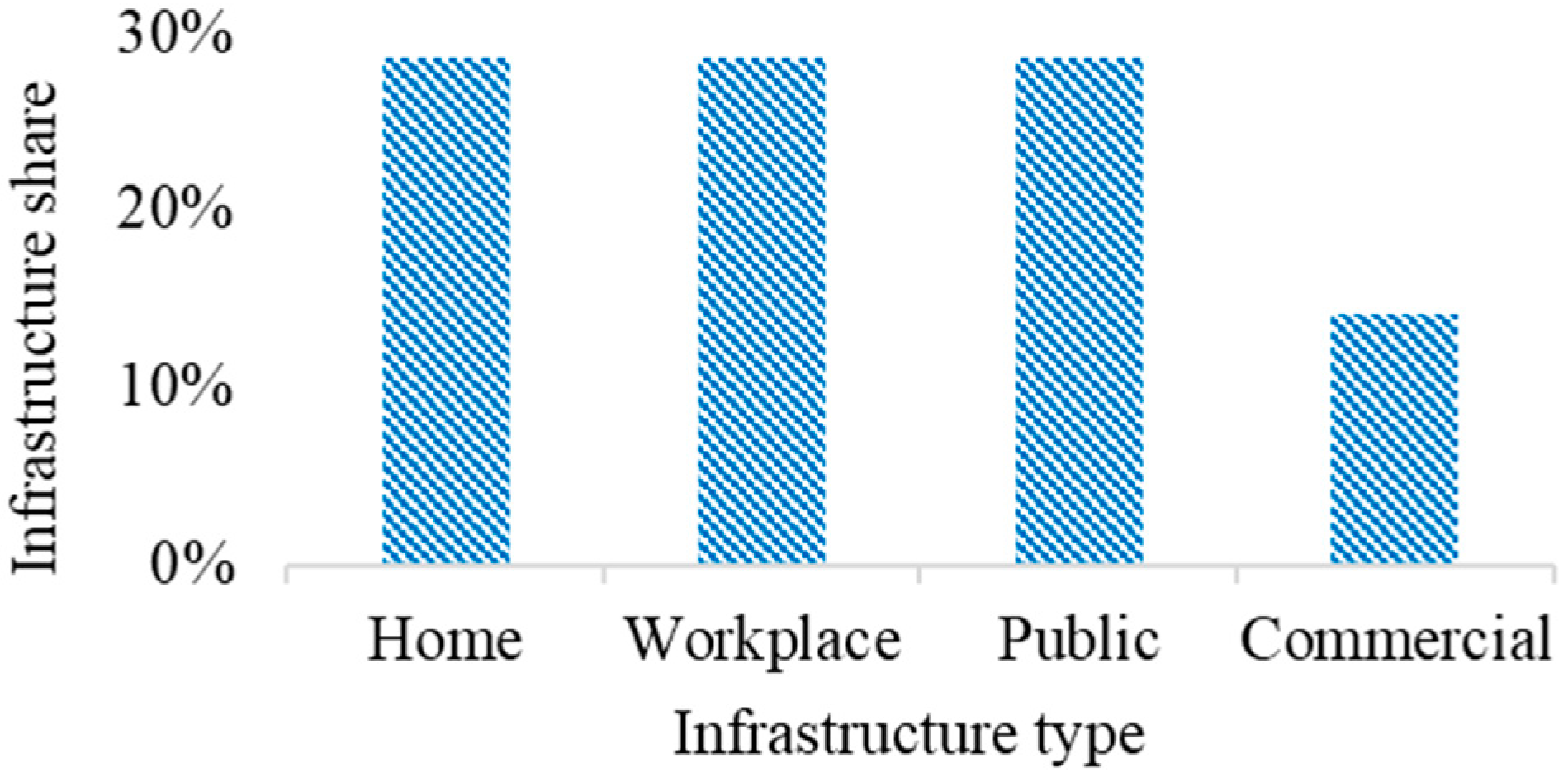
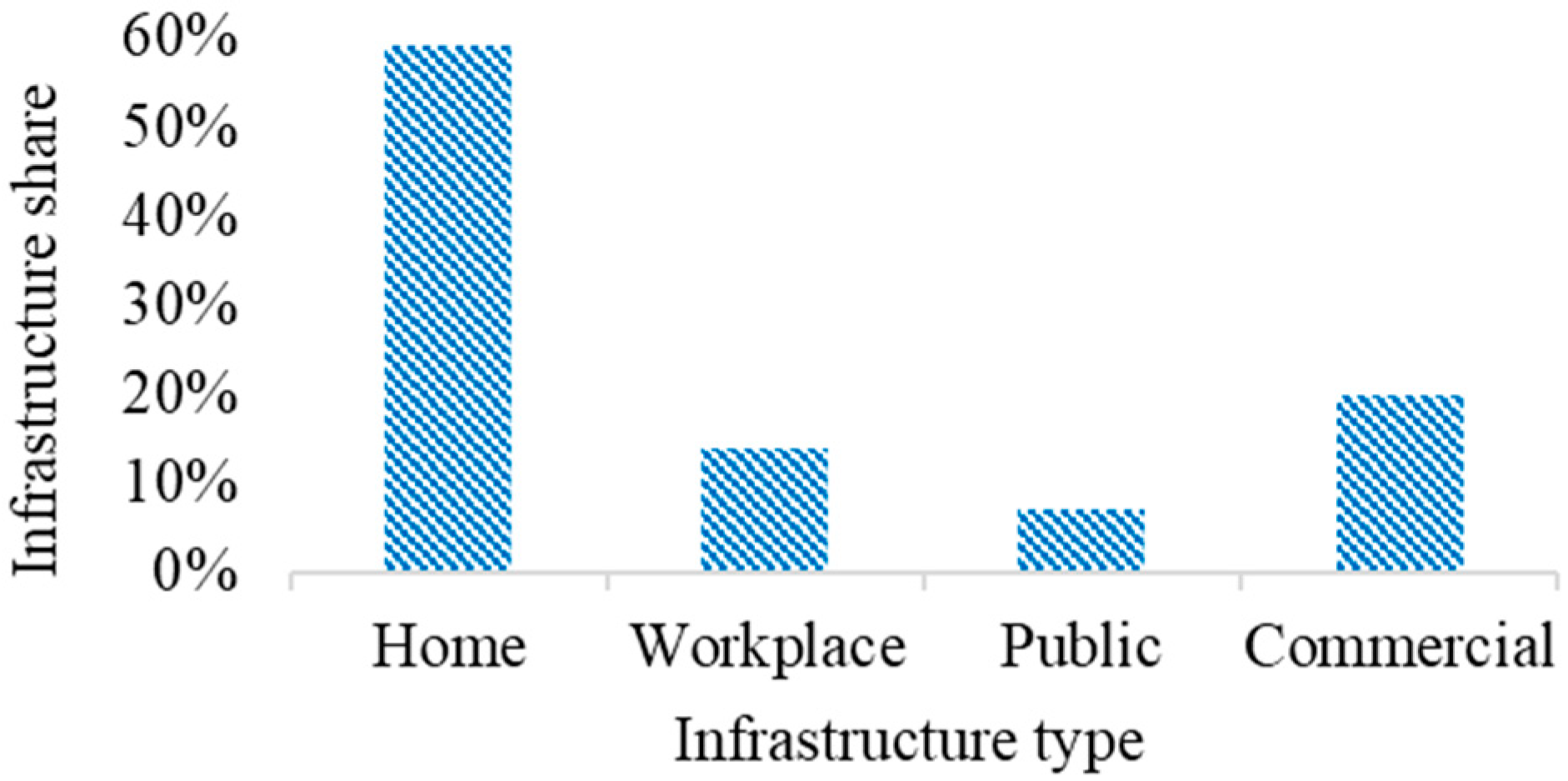
| EV Ratio (%) | Work L1 | Work L2 | Public L2 | Public FC | Home L1 | Home L2 | Commercial FC |
|---|---|---|---|---|---|---|---|
| 10 | 1.43 | 1.46 | 1.45 | 1.52 | 1.36 | 1.40 | 3.24 |
| 25 | 2.12 | 2.21 | 2.28 | 2.55 | 1.96 | 2.06 | 65.28 |
| 50 | 3.98 | 4.21 | 5.05 | 7.12 | 3.43 | 4.11 | 357.29 |
| EV Ratio (%) | Work L1 | Work L2 | Public L2 | Public FC | Home L1 | Home L2 | Commercial FC |
|---|---|---|---|---|---|---|---|
| 10 | 13.07 | 13.28 | 13.48 | 14.12 | 12.63 | 12.94 | 31.99 |
| 25 | 20.39 | 21.24 | 22.31 | 25.73 | 18.33 | 19.90 | 1206.10 |
| 50 | 42.38 | 46.22 | 53.27 | 74.89 | 34.05 | 41.82 | 18678.00 |
| EV Penetration Level | 10% | 25% | 50% |
|---|---|---|---|
| LOLE | 1.47 | 2.31 | 5.78 |
| LOEE | 13.57 | 22.56 | 61.94 |
| EV Penetration Level | 10% | 25% | 50% |
|---|---|---|---|
| LOLE | 1.47 | 2.41 | 8.28 |
| LOEE | 13.63 | 23.89 | 92.63 |
Publisher’s Note: MDPI stays neutral with regard to jurisdictional claims in published maps and institutional affiliations. |
© 2022 by the author. Licensee MDPI, Basel, Switzerland. This article is an open access article distributed under the terms and conditions of the Creative Commons Attribution (CC BY) license (https://creativecommons.org/licenses/by/4.0/).
Share and Cite
Almutairi, A. Impact Assessment of Diverse EV Charging Infrastructures on Overall Service Reliability. Sustainability 2022, 14, 13295. https://doi.org/10.3390/su142013295
Almutairi A. Impact Assessment of Diverse EV Charging Infrastructures on Overall Service Reliability. Sustainability. 2022; 14(20):13295. https://doi.org/10.3390/su142013295
Chicago/Turabian StyleAlmutairi, Abdulaziz. 2022. "Impact Assessment of Diverse EV Charging Infrastructures on Overall Service Reliability" Sustainability 14, no. 20: 13295. https://doi.org/10.3390/su142013295
APA StyleAlmutairi, A. (2022). Impact Assessment of Diverse EV Charging Infrastructures on Overall Service Reliability. Sustainability, 14(20), 13295. https://doi.org/10.3390/su142013295









